Project Rusinos Maximus P23
My good friend Piotr is an extremist. He stops at nothing to build the
ultimate highend system. So far he succeeded to get very very close,
and after just 15 years of building it - he discovered thanks to me the
beauty of vintage equipment and so we must start almost from scratch.
At least the speakers.
The monstrous Project4 had to go to the corner, and make room for the ultimate cost no object Project 23 Rusinos Maximus.
The design criteria: The best, cost no object, WAF no object, look no object speakers money can buy.
Sounds scary?
Well, it is not necessarily as expenceive as one might think, nor it must be hard to build.
It so happens that two of the three best drivers in a category is (WAS)
made by Altec Lansing - best bass drivers and best midrange (well, I
must admit - arguably best, because there are really no compromise
exotic midranges from Japan and Germany which are probably better, like
Feastrex D5NF Gold from Tokio)
But for the purity of the initial thesis, lets agree that Altec Biflex is a damned nice midrange.
Piotr decided, that since bass and mid will be Altec, it would be
particulary elegant and kosher thing to do to go all the way with Altec
and use their tweeter as well.
Below there are the beautiful alnico tweeters with original Lansing Trombas (horns).
I admit to have never heard these before, but I accept the challenge of
crossing them to the Biflex seamlessly at .. say .. 7kHz or so.
Tweter:
Altec Lansing 806-8A Alnico tube tweeters
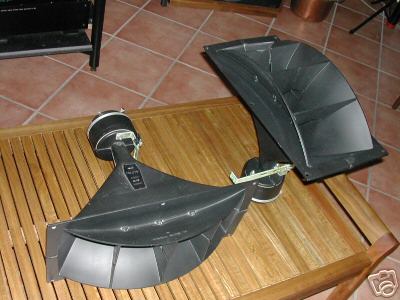
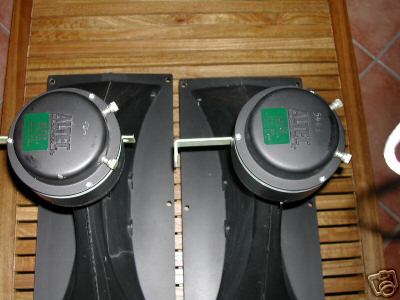
The horns are cast aluminium and the model is 811B
DATASHEET ALNICO HORNS
HORN 811
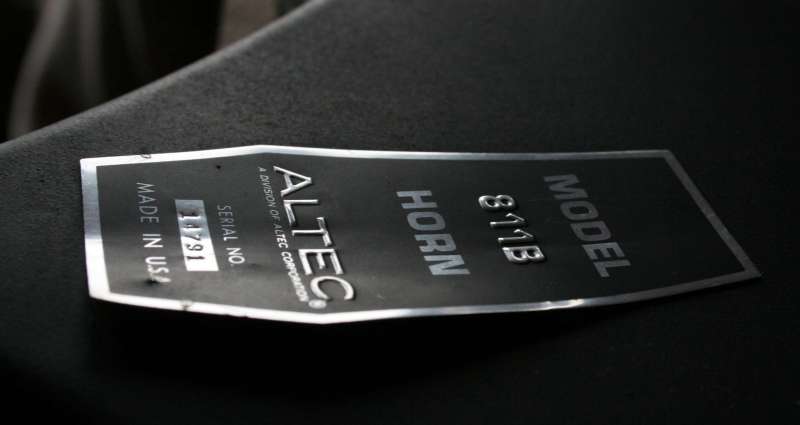
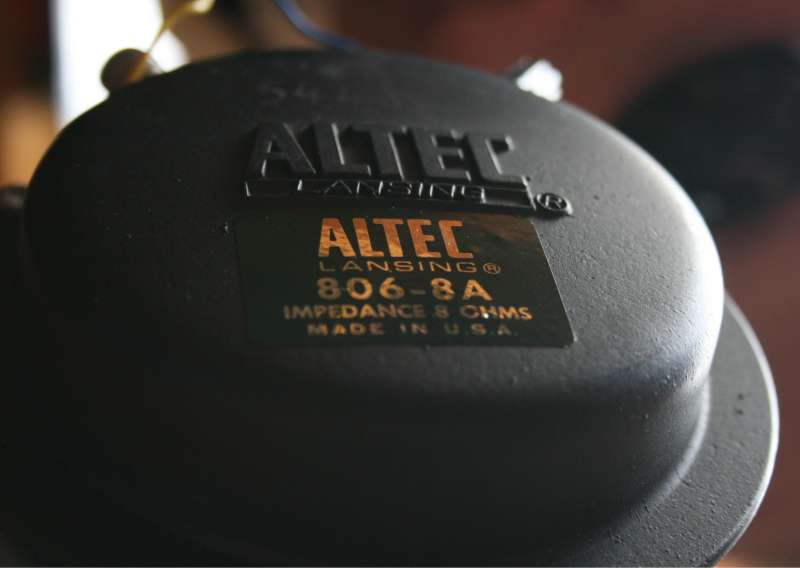
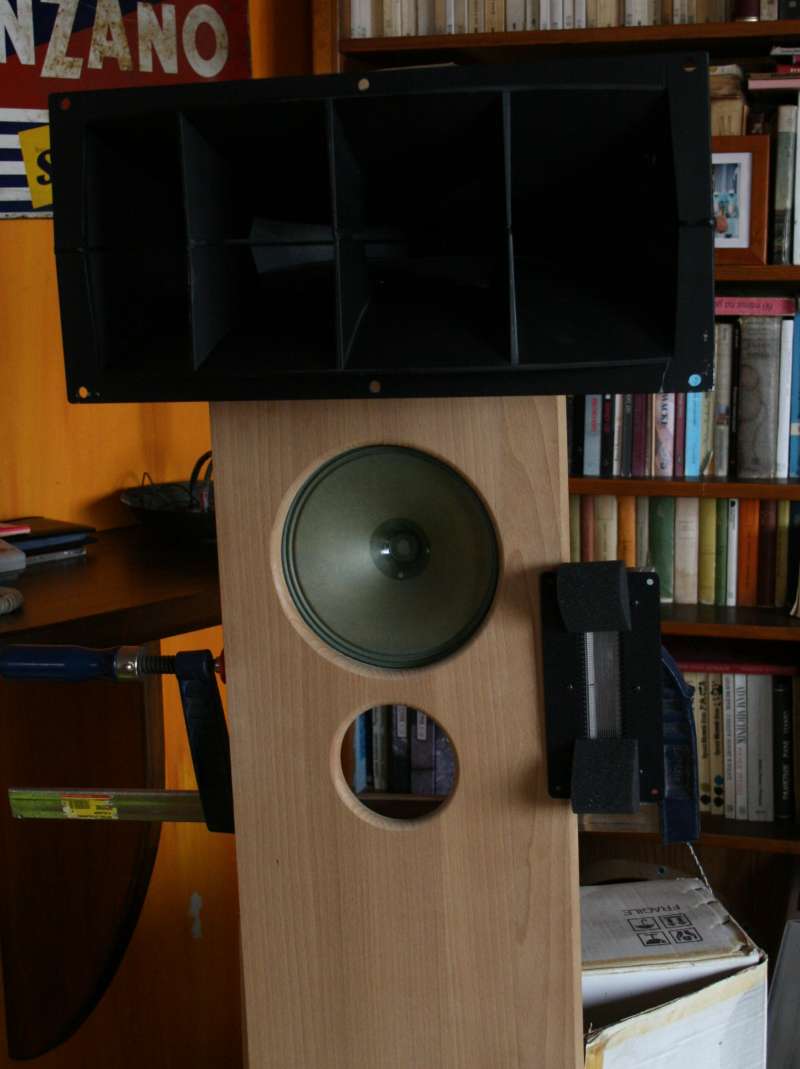 Test drive with the SABA and comparison to RAAL ribbons
Test drive with the SABA and comparison to RAAL ribbons
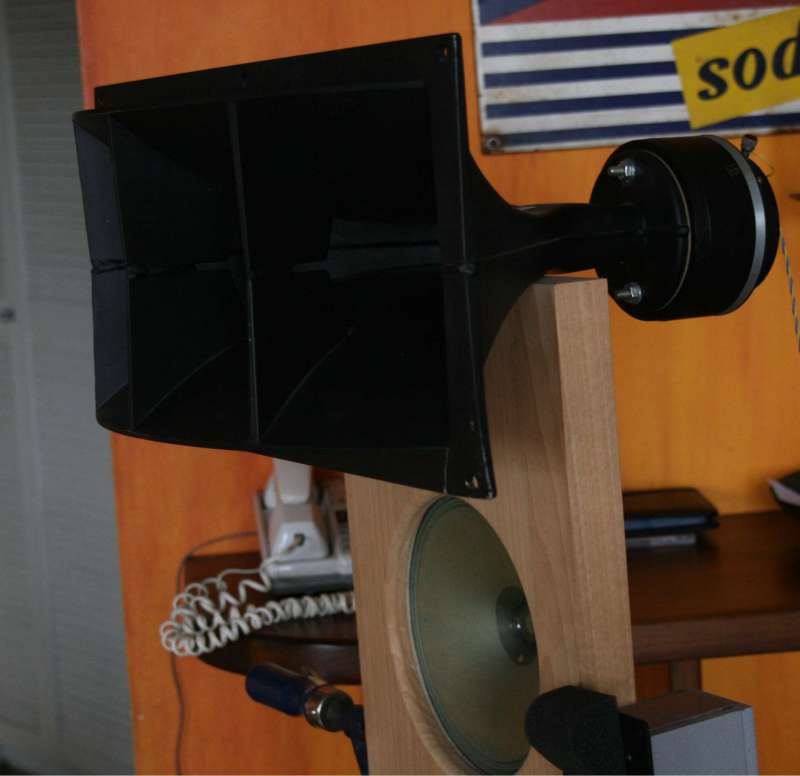
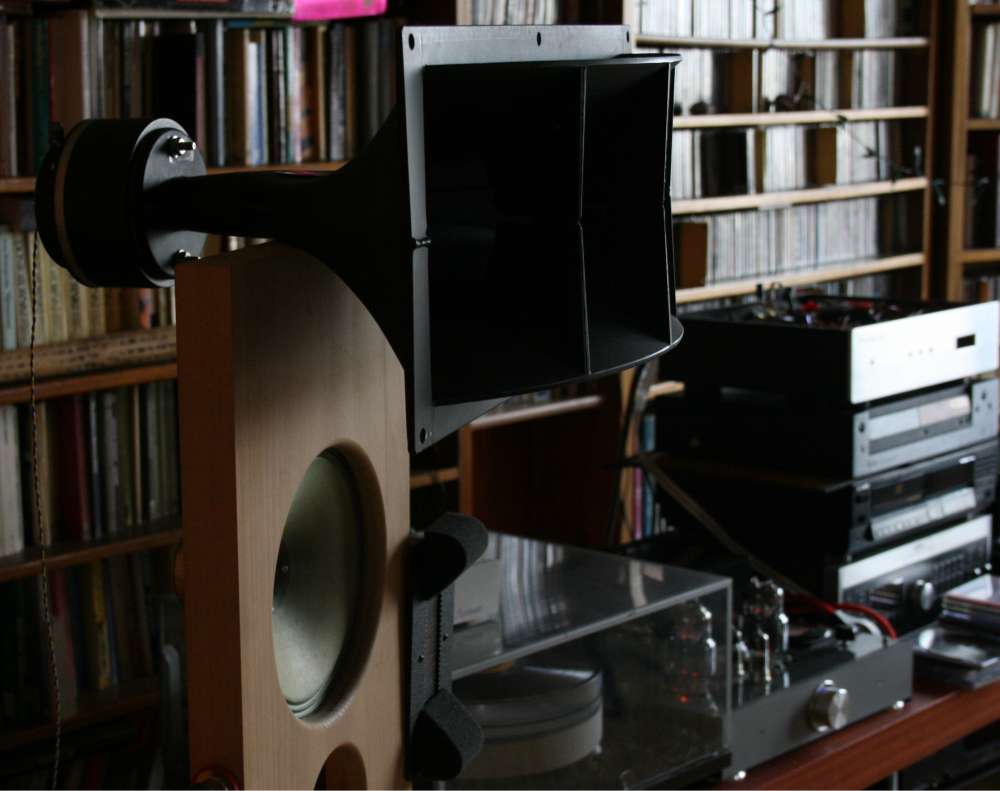
Midrange:
Altec Lansing Biflex 420A (15 inch Alnico midrange !!!)
On paper its usable range without any XO is 28-14000 Hz !
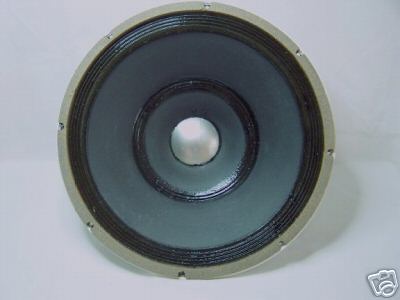
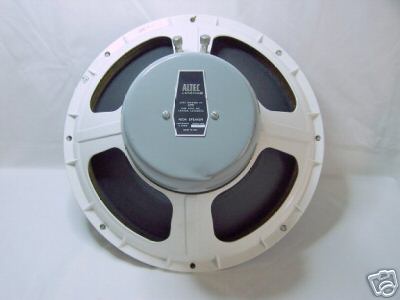
It has same basket as the bass drivers with 15 inch cast frame and
Alnico V magnet, but the paper cone is divided into two, connected by
specially selected suspension. It is like a 20 cm midrange glued to the
circular remains of a bass driver. At frequencies around 100 Hz the
mechanical coupling allows the surrounding bass part to start moving.
Above that - the surround is too heavy and behaves like a frame. Very
clever, inn'it? I think someone called this a "mechanical
crossover".
The first thing to do when you have this driver is to REMOVE the alu
dustcaps. Just pry it with a knife or something. They are added for "fake" HF
extension but we do not need this extra dirt on the pure sound.
Also see my own P24 for this driver details.
Bass:
The no-compromise member of our duo forced me
to use two basses per channel to compansate for the extraordinary
sensitivity of the two other drivers above.
So we will end up using 2 basses in a semi-open box, and mid/tweeter on open baffle standing separately.
Uff, I am glad Piotr did not request D'Apollito biflex arrangement. ;-)
2 per channel bass drivers Altec Lansing Alnico from 5xx series
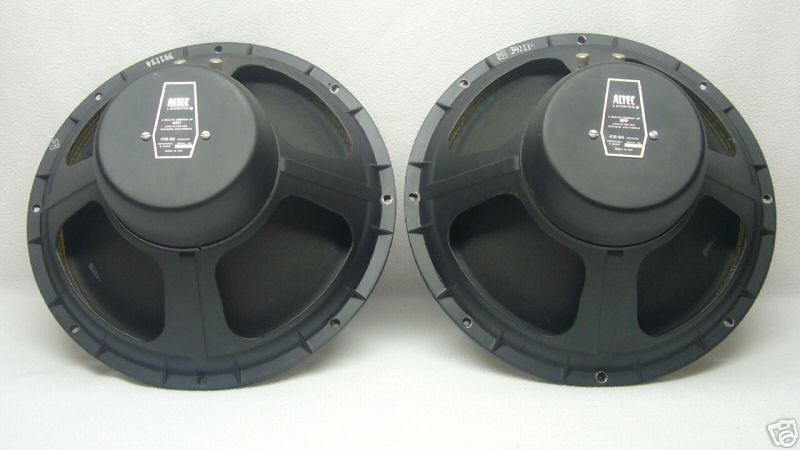
The XO will be a second order accoustical at 300 and 7000 Hz.
The completion date is probably before Christmas.
Which Christmas - our sources don't mention.
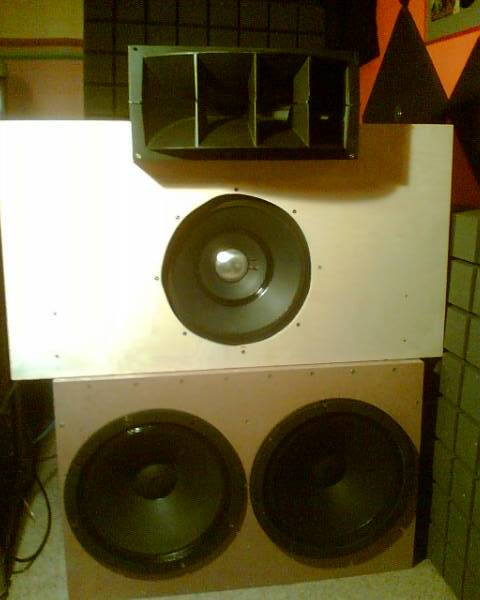
UPDATE in january 08 - the prototypes look really promising. And they
already sound great. Beforew any serious fine-tuning, the sound is
absolutely better than expected. I am stunned with the midrange quality
(best so far in my life) and also the horn tweeters prove to be
fantastic. I do not recall better trebles ever before. Blending them
though is a tough job.
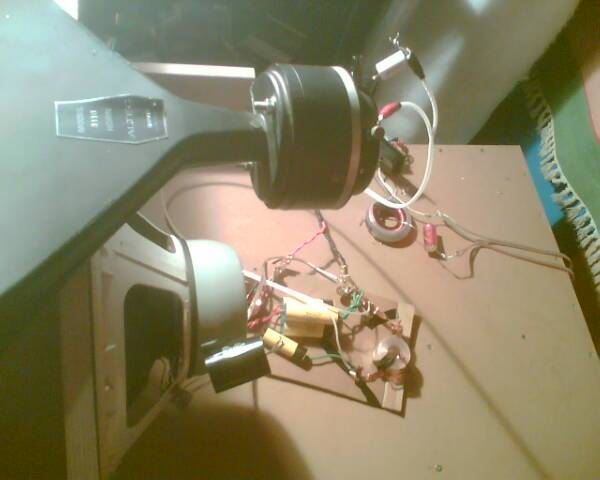
THE XO:
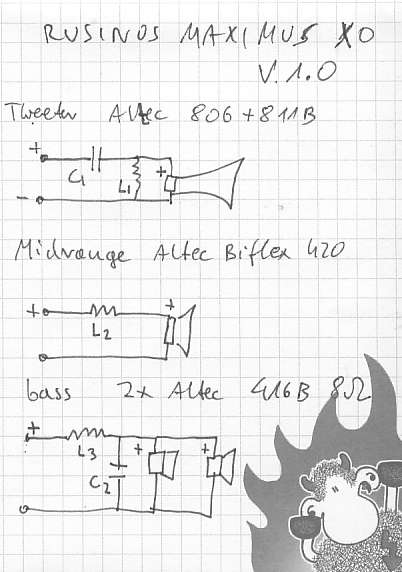
At the time of writing - 08 feb. 08 (I am flying over Greenland right
now) the XO is really simple. It took me 3 nights worth of testing to
arrive at these part values, and without my fantastic software TRUE RTA
I would have never done it. This tweeter is a nightmare to blend.
Anyway,
here it is: C1=1 uF (precisely); L1=0,39 mH (flatfoil)/
RDC < 0,5 Ohm; L2 = 1 mH RDC <0,5 Ohm; in addition L2 in
mid section should be preceeded by a capacitor in series - 100uF or
larger. L2 should be followed by the 10 uf paralell capacitor (can be
placed simply in speaker terminals.) L3 = 2,3
mH (or slightly bigger) and RDC < 1 Ohm; C2=10 uF MKT or
MKP, all phases are "positive".
First - the midrange - which is really the heart of the system. On open
baffle, sans dustcaps and without any filter - they sound just
fantastic. Almost well enough without any other stuff. So the
tweeter and the bass must only add one octave from each side of the
spectrum of the midrange. The spectral analysis of the biflex mid
reveals extremely uneven characteristics, which as usual sounds lively,
natural and rich. The only thing I wanted was to shave off the
tiny little bit of the front edge, the top of the driver response peak
near 15kHz. The L2 is just for that purpose. So the driver plus the L2
can be considered as a fullrange speaker with a re-touch correction.
This combination sounds smooth and natural. The human voices are from heaven.
Now comes the tricky part. The tweeter was designed to be really a
mid-tweeter in a two-way, to blend with the 15 inch bass unit at 1 kHz.
So it has WAAAY too much midrange content to begin with, plus the horn
makes it bloody loud. It must be 10 dB louder than the biflex.
So first I had to push the output to the righr, to roll it around
8-10kHz instead of its natural reach all the way down to 500 Hz. The
C1/L1 does just that (2-nd order electric and accoustic as well). At
the same time, the overall treble level comes down to acceptable volume
to blend with the biflex.
The magnets of biflex and tweeter horn are geometrically alligned.
The bass (two paralell drivers) are in the sealed box, and they must
reach a bit higher frequency than the usuall 300 Hz to support the
falling characteristics of the biflex, which is on open baffle. To
avoid a dry and lean sound, the bass is first order filtered at circa
800 Hz. Given the ULTRA SMOOTH behavior of the Altec bass in the
midrange zone, this is doable, unlike for typical modern bass drivers.
Overall, the measurements and listening show that this XO is a good
compromise. Over-filter - and you end up with dull, technical, closed
in sound. My XO strikes a balance where it measures kinda flat and
sounds like a live band visiting the room. YOUR ROOM. (Actually -
Peter's room really).
At realistic SPL the sensation is awesome. Even a couple of watts
literally nailed me to the chair. This is as far as you can get from a
BBC minimonitor on stands kind of over-civillised hifi sound.
Second iteration of the system (in the center
there is a pair of Altec speakers with Biflex drivers and even more
center - the happy owner Piotr) Picture is from a telephone.
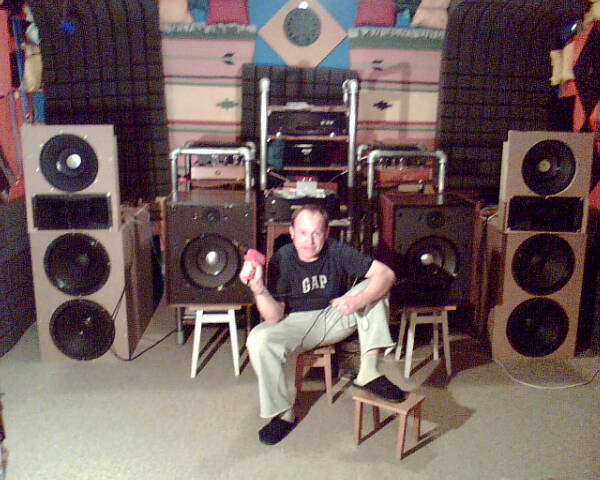
BACK



 Test drive with the SABA and comparison to RAAL ribbons
Test drive with the SABA and comparison to RAAL ribbons




